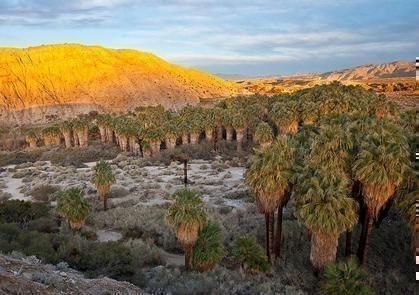Coachella Valley Preserve | California
For information regarding the Coachella Valley Preserve and Visitor Center managed by the Center for Natural Lands Management, please call 760.343.1234 or visit https://www.cnlm.org/portfolio_page/coachella-valley/.
For thousands of years, particles of sand from the San Bernardino Mountains and Indio Hills washed into the Coachella Valley, forming a system of dunes. Today, these dunes are part of the Coachella Valley Preserve System, a 20,000-acre sanctuary that is home to several species of increasingly rare wildlife. The Coachella Valley fringe-toed lizard depends on this unusual blowsand desert for survival, and "swims" through the sand to escape predators or summer heat on the desert surface. Four other unique wildlife species can also be found here: the Coachella roundtailed ground squirrel, the giant red velvet mite, the flat-tailed horned lizard and the giant palm-boring beetle. The Coachella Valley Preserve also contains several palm oases, formed because San Andreas Fault lines allow water flowing underground to rise to the surface. The spectacular Thousand Palms Oasis includes a mile-long trail that winds past pools containing endangered desert pupfish. Native vegetation includes creosote bush, burrobush, smoke tree and desert lavender, part of this area's unique habitat for wildlife. The Coachella Valley Preserve is administered by BLM's Palm Springs-South Coast Field Office and the Center for Natural Lands Management.
Photos
ANIMALS YOU MAY SEE HERE
- Birds: More than 183 bird species have been recorded here, including Gambel's quail, black-throated sparrows, phainopeplas, black-tailed gnatcatchers and American bitterns. Cactus wrens nest among the chollas. Year-round, visitors can view songbirds, upland birds and birds of prey. Spring and fall are good times to view songbirds.
- Other animals that live in this area include black-tailed jackrabbits, bobcats, and sidewinders. Reptiles may be seen in the summer. Spring through fall is the best time to look for fish in the pools.
VIEWING TIPS FOR THIS AREA
- This area is very hot during the summer - be prepared.
- The Preserve includes a visitor's center and equestrian trails.
- The Preserve is open seven days a week.
- Be sure to see tips for "Ultimate Wildlife Watching."
Contact Us
Geographic Coordinates
Directions
Take Interstate 10 to the Bob Hope exit (about 10 miles east of Palm Springs);go north and turn right on Varner road. At Ramon Road, turn left. Drive east to Thousand Palms Canyon Drive. Turn north and drive about two miles to the entrance.


